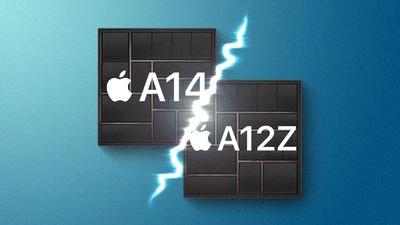The A12Z and A14 Bionic chips are two powerful processors manufactured by Apple that are commonly found in their devices. While both chips offer impressive performance, there are distinct differences between them that are worth exploring.
Let’s start with the A12Z chip, which is typically found in Apple’s iPad Pro models. This chip boasts a maximum clock speed of 2.49GHz, allowing it to handle demanding tasks with relative ease. It features Apple’s “next-generation Neural Engine,” a dedicated neural network hardware capable of performing up to 5 trillion operations per second. This neural network hardware enhances the chip’s ability to handle artificial intelligence and machine learning tasks efficiently.
Moving on to the A14 Bionic chip, which is found in the latest iPhone models, including the iPhone 12 series. The A14 chip takes performance to the next level with a higher clock speed of 3.2GHz. This increased speed allows for faster processing and improved overall performance. The A14 chip also includes Apple’s latest neural engine, which offers improved capabilities over its predecessor.
One area where the A14 chip truly shines is in single-core performance. It outperforms the A12Z chip by approximately 30 percent in this aspect. The higher clock speed and boost capability of the A14 chip contribute to its superior performance in single-core tasks. This improvement demonstrates Apple’s dedication to enhancing the power of their chips with each new generation.
While the A12Z chip is still quite powerful, opting for a device with the A14 chip would provide better future-proofing. The A14 chip’s superior clock speed and overall performance make it a more capable option for handling demanding tasks and running resource-intensive applications.
Both the A12Z and A14 Bionic chips offer impressive performance capabilities. The A12Z chip, with its dedicated neural engine, is a powerful choice for AI and machine learning tasks. However, the A14 chip takes performance to the next level with its higher clock speed and enhanced neural engine. If you’re looking for the most advanced and future-proofed option, the A14 chip is the way to go.
Is A12Z Bionic Better Than A14 Bionic?
The A12Z Bionic chip is not better than the A14 Bionic chip. In fact, the A14 Bionic chip outperforms the A12Z Bionic chip in several aspects.
1. Single-core Performance: The A14 Bionic chip performs around 30 percent better than the A12Z Bionic chip for single-core tasks. This improvement can be attributed to the higher clock speed and boost capability of the A14, which operates at 1.8 GHz and can boost up to 3.01 GHz. This increase in performance showcases how Apple has enhanced the power of the chip over two generations.
2. Multi-core Performance: While it is not explicitly mentioned in the question, it is worth noting that the A12Z Bionic chip is an 8-core chip, whereas the A14 Bionic chip is a 6-core chip. However, the A14 still manages to outperform the A12Z in both single-core and multi-core tasks, indicating that Apple’s optimizations have significantly boosted its overall performance.
3. Efficiency: The A14 Bionic chip is built on a 5-nanometer process, which makes it more power-efficient compared to the A12Z Bionic chip. This improved efficiency allows for better battery life and overall device performance.
The A14 Bionic chip surpasses the A12Z Bionic chip in terms of both single-core and multi-core performance, as well as power efficiency. Apple’s advancements in chip design and technology have contributed to the superior capabilities of the A14 Bionic chip.

How Powerful Is The A12Z Bionic Chip?
The A12Z Bionic chip, developed by Apple, is a highly powerful and advanced piece of technology. It boasts exceptional performance capabilities, making it an impressive addition to Apple’s lineup of processors. The A12Z chip incorporates a dedicated neural network hardware, known as the “next-generation Neural Engine.” This Neural Engine is the same as that found in the A12 chip, with the ability to execute up to a staggering 5 trillion operations per second.
The A12Z Bionic chip’s neural network hardware is designed specifically for handling complex machine learning tasks and artificial intelligence processes. This dedicated hardware enables the chip to efficiently process and analyze vast amounts of data, resulting in enhanced performance and speed.
To summarize the power of the A12Z Bionic chip:
– It utilizes a next-generation Neural Engine, the same as found in the A12 chip.
– The chip can execute up to 5 trillion operations per second.
– Its neural network hardware is optimized for machine learning and artificial intelligence tasks.
– The chip’s capabilities enable it to process and analyze large volumes of data efficiently.
The A12Z Bionic chip is a highly powerful and capable processor, equipped with advanced neural network hardware, making it suitable for handling demanding tasks and delivering impressive performance.
Is The A12Z Still Good?
The A12Z chip, although not the latest in Apple’s lineup, is still a capable processor. It offers impressive performance and can handle most tasks with ease. However, when it comes to future-proofing your device, it’s worth considering the more recent M1 chip.
The A12Z chip was first introduced in the iPad Pro (2020) and offers high-performance capabilities. It features an eight-core CPU and an eight-core GPU, providing excellent processing power for various applications. With this chip, you can comfortably run demanding tasks such as video editing, gaming, and multitasking.
The A12Z chip also supports advanced technologies like machine learning and augmented reality, making it suitable for those interested in these areas. It delivers smooth performance and enhances the overall user experience.
That being said, the M1 chip, which is found in the latest Macs, offers even more power and efficiency. It boasts an eight-core CPU, an eight-core GPU, and a 16-core Neural Engine. This combination delivers exceptional performance across a wide range of applications, making it ideal for professionals and power users.
By adopting the M1 chip, you can enjoy faster processing speeds, improved graphics performance, and better power efficiency. The M1 chip also supports unified memory architecture, which enhances overall system performance and responsiveness.
While the A12Z chip is still a good option and can handle most tasks effectively, opting for a device with the M1 chip would provide you with a more future-proofed and powerful experience. The M1 chip’s superior performance, efficiency, and advanced features make it a better choice for those seeking the best possible performance and longevity.
Is The M1 Chip Better Than The A12Z?
The M1 chip is indeed better than the A12Z chip. One of the major factors contributing to its superiority is the higher clock speed. While the A12Z chip has a maximum clock speed of 2.49GHz, the M1 chip boasts a significantly higher clock speed of 3.2GHz.
Here are a few key points to consider about the M1 chip’s superiority over the A12Z chip:
1. Clock Speed: The M1 chip operates at a maximum clock speed of 3.2GHz, which is noticeably higher than the A12Z chip’s maximum clock speed of 2.49GHz. This higher clock speed allows the M1 chip to perform tasks more quickly and efficiently, resulting in improved overall performance.
2. Efficiency: The M1 chip is based on Apple’s custom ARM architecture, which is known for its energy efficiency. This means that the M1 chip delivers high performance while consuming less power, resulting in longer battery life for devices equipped with this chip.
3. Unified Memory Architecture: The M1 chip features a unified memory architecture, which allows both the CPU and GPU to access the same memory pool. This enables faster data transfer and reduces latency, resulting in improved performance and responsiveness.
4. Neural Engine: The M1 chip includes a dedicated neural engine, which enhances machine learning and AI capabilities. This allows for faster and more efficient processing of tasks related to image recognition, natural language processing, and other AI-driven applications.
5. Performance per Watt: The M1 chip delivers exceptional performance per watt, outperforming the A12Z chip in terms of energy efficiency. This means that the M1 chip can perform more tasks while consuming less power, resulting in a better overall user experience.
The M1 chip’s higher clock speed, energy efficiency, unified memory architecture, neural engine, and superior performance per watt make it a better option compared to the A12Z chip.
Conclusion
The A12Z and A14 Bionic chips are both powerful processors designed by Apple for their respective devices. However, when it comes to single-core performance, the A14 outshines the A12Z with its higher clock speed and boost capability. The A14 performs around 30 percent better in single-core tasks, showcasing the significant improvement Apple has made in power over two generations.
Both the A12Z and A14 chips feature dedicated neural network hardware, known as the “next-generation Neural Engine,” which enables them to perform advanced machine learning tasks. The A12Z can handle up to 5 trillion operations per second, similar to the A12 chip. On the other hand, the A14 Bionic chip offers a more futureproof solution, with its higher clock speed of 3.2GHz compared to the A12Z’s maximum clock speed of 2.49GHz.
If you are looking for a device with increased performance and better overall futureproofing, the A14 Bionic chip would be the recommended choice. Its superior single-core performance and higher clock speed make it a more capable processor for demanding tasks and potential advancements in technology. However, if you already own a device with the A12Z chip, it is still a powerful option, but it may not offer the same level of performance and longevity as the A14 Bionic chip.








